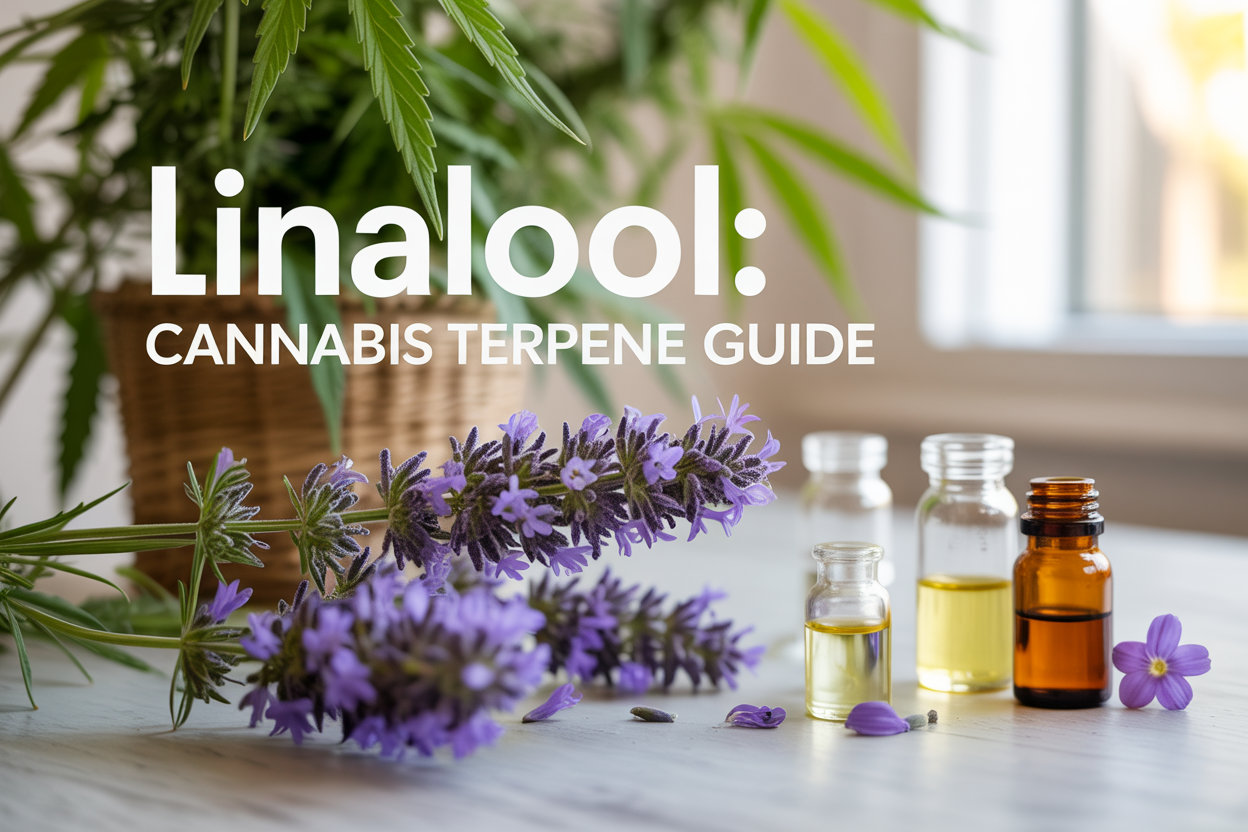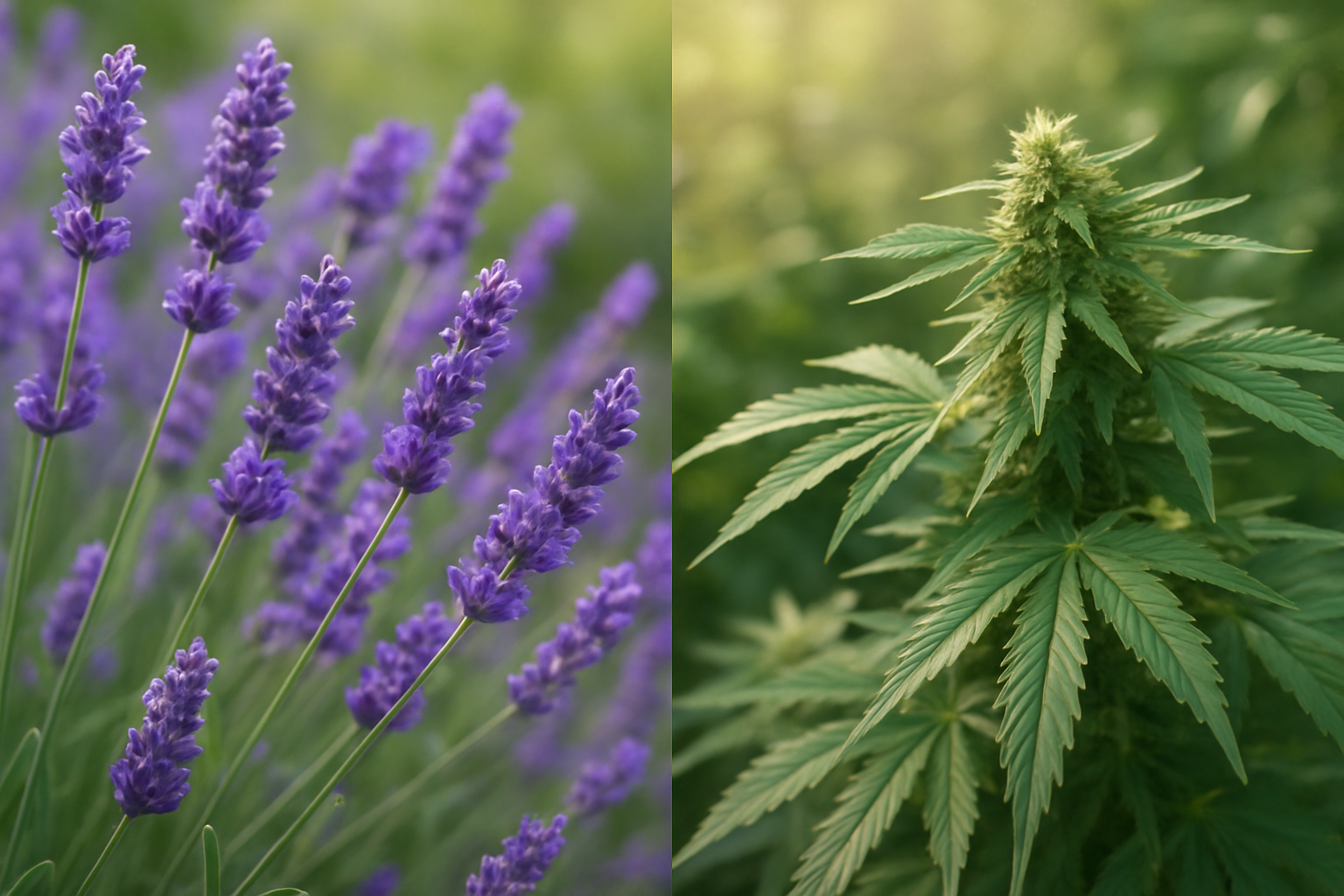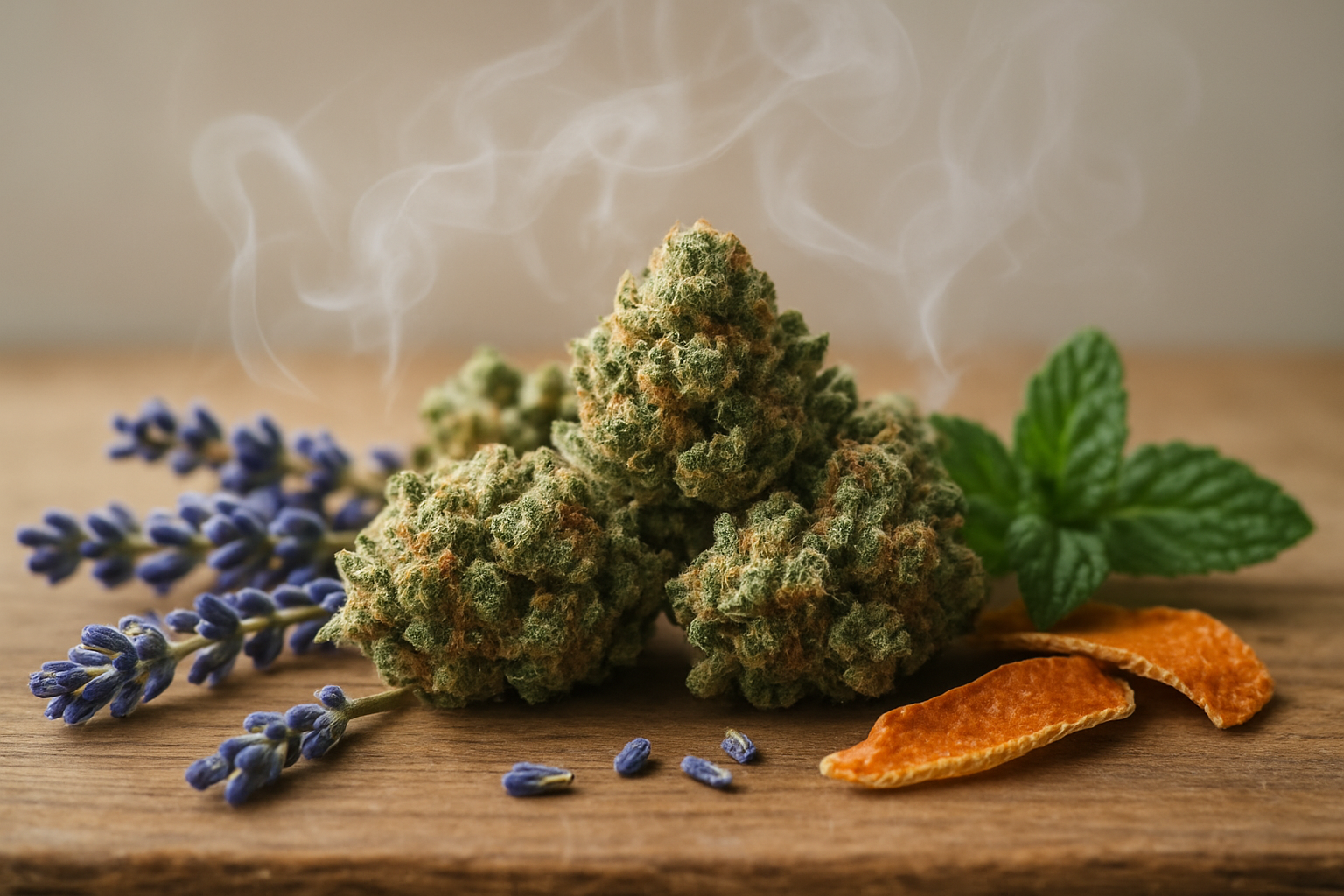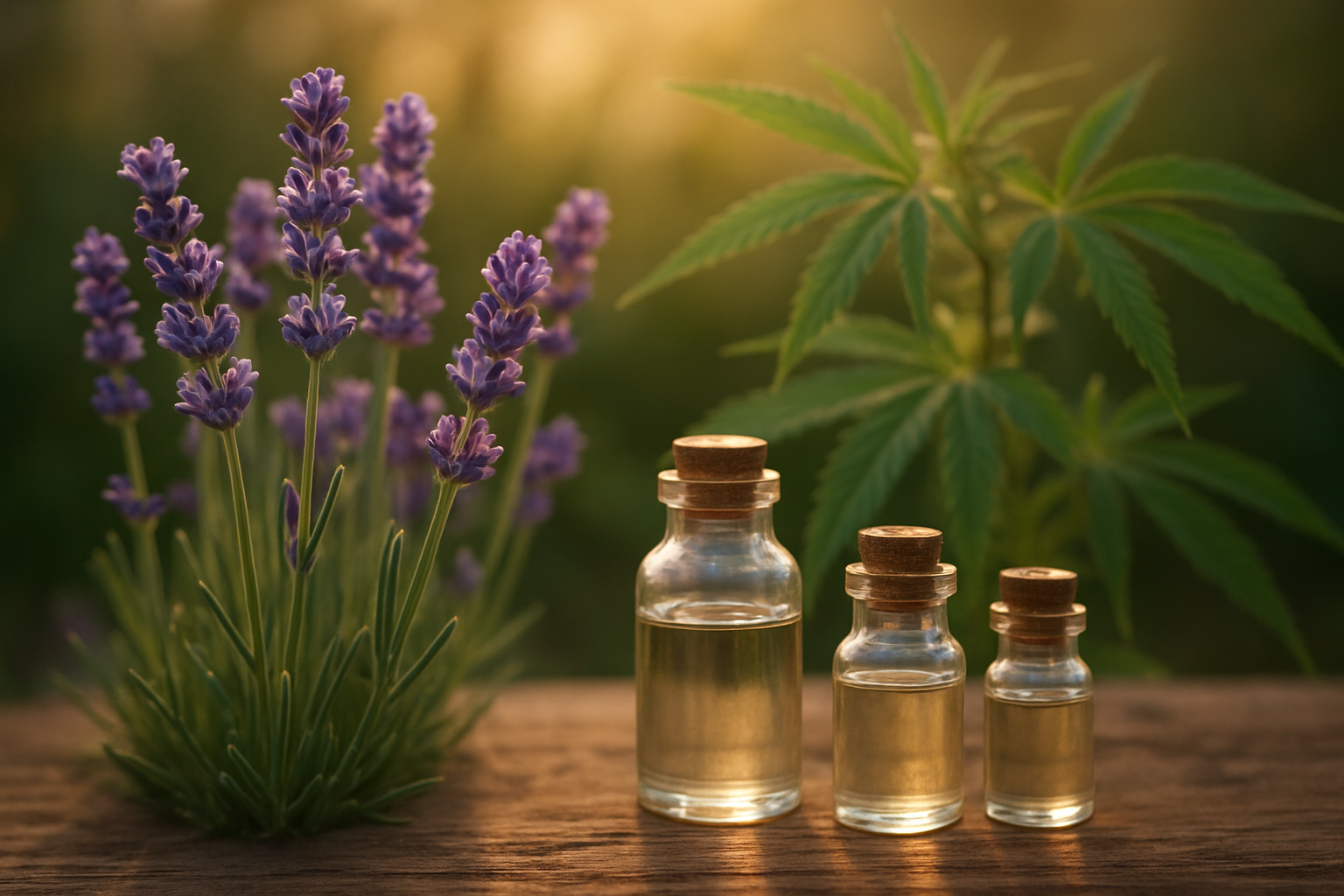Nov 25, 2025

If you've ever wondered why certain cannabis strains smell like lavender or why some varieties make you feel instantly relaxed, linalool holds the answer. This naturally occurring terpene creates the distinctive floral and citrusy aromas found in popular cannabis strains while delivering some impressive effects that have caught the attention of both recreational users and medical patients.
This guide is perfect for cannabis enthusiasts, medical marijuana patients, and anyone curious about the science behind what makes different strains unique. Understanding linalool helps you make smarter choices about the cannabis products you use and explains why certain strains work better for relaxation, sleep, or stress relief.
We'll start by exploring what linalool actually is and where it shows up in nature beyond cannabis plants. Then we'll dive into how this terpene shapes the aroma profiles of specific cannabis strains and why it matters for your overall experience. Finally, we'll look at how New York's regulated cannabis market is making terpene information more accessible to consumers who want to understand exactly what they're buying.

Linalool is part of the terpene family — the aromatic compounds that give many plants their signature scents and flavors. Chemically, it’s classified as a monoterpene, a smaller and more volatile type of terpene known for its light, floral aroma. Its simple structure is one reason linalool shows up so frequently in nature, appearing in everything from lavender and basil to certain cannabis strains.
As a monoterpene, linalool evaporates easily and contributes strongly to a plant’s overall aroma profile. This volatility helps shape the distinctive scent notes people often associate with linalool-rich cannabis strains, giving them that familiar fresh, calming, floral quality many consumers recognize and enjoy.
Linalool shows up in far more places than just cannabis — it’s one of the most widespread aromatic terpenes found in nature. Lavender is one of the best-known sources, giving the plant its familiar floral fragrance that many people instantly recognize. You’ll also find linalool in citrus fruits like oranges, where it helps create the bright, slightly sweet aroma that comes from their peels.
Outside the garden and fruit bowl, this terpene appears in rosewood, certain mints, coriander, and even a touch in cinnamon. Each plant carries its own unique blend of aromatic compounds, and linalool plays a key role in shaping the distinct scent profiles that make these botanicals so recognizable across different cultures and traditions.
Linalool actually appears in two closely related forms in nature: its primary terpene structure and a naturally occurring variation called linalyl acetate. These two versions often show up together in the same plants, contributing to the layered, complex aromas we associate with things like lavender, citrus, and certain cannabis strains.
Instead of acting like completely separate compounds, linalool and linalyl acetate tend to complement one another. Their presence side-by-side helps create richer, fuller scent profiles that feel more rounded than what you’d get from either one on its own. Many botanicals rely on this blend to achieve their signature aromatic character, which is why the combination is so common across the plant world.
Across many cultures, plants containing linalool have played meaningful roles in traditional herbal practices. In places like China, India, Egypt, and Rome, botanicals such as lavender, coriander, and rosewood were commonly incorporated into daily rituals, wellness traditions, and aromatic preparations. These plants were often valued for their pleasant scents and their place in cultural practices that supported relaxation, rest, or general well-being.
Different regions used these aromatic plants in their own ways—burned as incense, blended into oils, added to baths, or included in herbal mixtures. While each culture approached them differently, their widespread use shows just how long people have been drawn to the distinctive floral, citrusy character of linalool-rich botanicals. These traditions help explain why linalool remains such a recognizable and appreciated scent in modern aromatherapy, perfumery, and cannabis conversations today.

Linalool shows up in an impressive variety of plants across different families and continents. Lavender stands as perhaps the most famous linalool-rich plant, with some varieties containing up to 40% linalool in their essential oils. The distinctive floral sweetness we associate with lavender comes largely from this single terpene.
Basil varieties showcase linalool's versatility, with sweet basil containing significant amounts alongside other aromatic compounds. The herb's complex scent profile relies heavily on linalool's contribution to create that fresh, slightly spicy fragrance that makes it so popular in cooking and aromatherapy.
Coriander seeds pack surprisingly high linalool concentrations, often reaching 70% of their total essential oil content. This explains the citrusy, almost floral notes that distinguish coriander from other spices. Bergamot, the citrus fruit that gives Earl Grey tea its signature flavor, owes much of its distinctive character to linalool working alongside other citrus terpenes.
Other notable linalool sources include:
Rosewood trees (up to 85% linalool content)
Mint species, particularly spearmint
Thyme varieties
Ylang-ylang flowers
Geranium plants
Clary sage
Bay laurel leaves
Linalool acts as a master blender in nature's aromatic symphony, rarely performing solo but instead harmonizing with other compounds to create complex, appealing scents. The molecule exists in two mirror-image forms called enantiomers, and each contributes different aromatic qualities. S-linalool tends toward sweet, floral notes, while R-linalool leans more woody and spicy.
In lavender, linalool pairs with linalyl acetate to create that instantly recognizable calming fragrance. The combination produces a scent that's simultaneously fresh and powdery, explaining why lavender has been prized for centuries in perfumery and household applications.
Basil demonstrates linalool's chameleon-like qualities. Here, it mingles with eugenol and methyl chavicol to produce basil's characteristic peppery-sweet aroma. The linalool component adds a softening floral note that balances the sharper, more pungent elements.
Different plants use varying linalool concentrations to achieve their signature scents:
| Plant | Linalool Content | Scent Contribution |
|---|---|---|
| Sweet Basil | 20-40% | Floral sweetness |
| Lavender | 30-40% | Powdery, calming |
| Coriander | 60-70% | Citrusy brightness |
| Bergamot | 15-25% | Fresh, sophisticated |
The timing of linalool release also matters. Many plants produce higher concentrations during evening hours, aligning with pollinator activity patterns.
Aromatic compounds like linalool serve multiple survival functions that go far beyond simply smelling nice to humans. Plants evolved these chemical messengers over millions of years as sophisticated communication and defense systems.
Pollinator attraction represents one of linalool's most important ecological roles. The sweet, floral scent draws bees, butterflies, and other beneficial insects from considerable distances. Different pollinators respond to different linalool concentrations and combinations, allowing plants to target specific species that provide the most effective pollination services.
Defense mechanisms showcase linalool's protective qualities. Many plants increase linalool production when attacked by herbivores or pests. The compound can repel harmful insects while simultaneously attracting predatory species that feed on plant pests. This creates a natural biological control system that protects the plant without requiring toxic compounds.
Allelopathy, or chemical warfare between plants, represents another fascinating linalool function. Some plants release linalool through their roots or leaves to inhibit competing vegetation growth nearby. This gives linalool-producing plants advantages in crowding situations by essentially creating chemical boundaries around their territory.
Environmental stress triggers also influence linalool production. Plants often increase aromatic compound production during drought, extreme temperatures, or other challenging conditions. Scientists believe these compounds help plants cope with stress while signaling their condition to surrounding organisms.
Soil microorganisms respond positively to many aromatic compounds, including linalool. These chemical signals can promote beneficial bacterial and fungal relationships that improve nutrient uptake and disease resistance, creating healthier plant communities overall.

Cannabis plants showcase remarkable genetic diversity that translates directly into their aromatic profiles. Each cultivar carries unique genetic instructions that determine which terpenes the plant produces and in what concentrations. These genetic blueprints work like aromatic recipes, creating distinct scent signatures that can range from citrusy and bright to earthy and musky.
Environmental factors play a major role in shaping terpene expression. Growing conditions such as temperature, humidity, light exposure, and soil composition can dramatically influence which terpenes a plant produces. A single cultivar grown in different environments might develop completely different aromatic characteristics. Indoor cultivation allows growers to fine-tune these conditions, potentially enhancing specific terpene profiles.
The timing of harvest also impacts terpene content. Terpenes are volatile compounds that can degrade or change as the plant matures. Some cultivars reach peak terpene production before full maturity, while others continue developing complex aromatic profiles right up to harvest. This creates another layer of complexity in the aromatic diversity we see across different cannabis products.
Breeding practices have amplified this natural diversity. Cannabis breeders specifically select parent plants with desirable terpene profiles, creating new cultivars with enhanced aromatic characteristics. Some modern cultivars have been developed specifically for their unique terpene combinations, resulting in unprecedented aromatic complexity that goes far beyond traditional cannabis scents.
Modern cannabis testing laboratories use sophisticated analytical equipment to identify and quantify terpenes with remarkable precision. Gas chromatography-mass spectrometry (GC-MS) represents the gold standard for terpene analysis. This technology separates individual terpene compounds and measures their exact concentrations, typically reported in milligrams per gram or as percentages of total dry weight.
The testing process begins with careful sample preparation. Laboratory technicians extract terpenes from cannabis samples using specialized solvents or steam distillation methods. These extraction techniques must preserve the delicate terpene compounds while removing unwanted plant materials that could interfere with accurate measurements.
Testing labs typically screen for a standard panel of common cannabis terpenes, though this can vary between facilities. Most labs test for primary terpenes like myrcene, limonene, pinene, linalool, and caryophyllene, along with secondary terpenes that appear in smaller quantities. Some advanced laboratories offer expanded terpene panels that can identify dozens of different aromatic compounds.
Results appear on certificates of analysis as detailed breakdowns showing each detected terpene and its concentration. These reports often include visual representations like pie charts or bar graphs that help consumers understand the terpene profile at a glance. The total terpene content provides an overall measure of aromatic intensity, while individual terpene percentages reveal the specific aromatic character consumers can expect.
Quality control measures ensure accuracy across different testing facilities. Laboratories use certified reference standards and participate in proficiency testing programs to maintain consistent results. This standardization helps consumers make informed decisions based on reliable terpene data.

Linalool brings a distinctly floral character to certain cannabis cultivars, giving them aromatic profiles often compared to lavender, fresh herbs, or soft citrus. These scents tend to feel gentle and fragrant, setting linalool-forward varieties apart from the sharper, fuel-like aromas found in other parts of the cannabis family.
Cultivars such as Lavender, Purple Kush, and Amnesia Haze are well-known for showcasing these floral qualities. Many people describe subtle layers within their aroma—notes of vanilla, spice, or light woody accents that complement the primary lavender-like fragrance. Some compare the overall scent to high-end botanical soaps, essential oils, or a walk through a garden filled with blooming herbs.
The depth of these linalool-driven aromas can shift depending on how the plant is grown and prepared. Freshly harvested flower often leans brighter and more citrus-forward, while a proper curing process can bring out richer, rounder floral notes that evolve over time.
Cannabis aroma rarely comes from a single terpene working on its own. Linalool often appears alongside other aromatic compounds, and together they create layered, nuanced scent profiles. This natural blending is similar to how ingredients come together in a perfume—each terpene adds its own character while helping shape the overall fragrance.
When linalool appears with myrcene, the pairing often introduces earthy, musky undertones that soften and balance the floral notes. When limonene is in the mix, the result can lean brighter and more citrus-forward, almost like blooming citrus flowers. Pinene can add crisp, forest-like aromas that bring a fresh, herbal edge to the bouquet.
Caryophyllene contributes gentle peppery or spicy hints, while terpinolene can bring in pine, herbal, or subtly sweet notes. These combinations create multi-dimensional aroma profiles that feel more complete and expressive than any single terpene on its own.
The balance of these terpenes makes a noticeable difference. A cultivar with higher linalool and moderate myrcene might give off a lavender-honey fragrance, while the same amount of linalool paired with dominant pinene could smell more herbaceous and garden-fresh.
Even cultivars with similar terpene profiles can smell remarkably different due to subtle variations in their chemical composition and environmental factors. Growing conditions play a huge role in determining final aromatic outcomes. Temperature fluctuations, humidity levels, soil composition, and lighting intensity all influence how terpenes develop and concentrate within the plant tissue.
Harvest timing creates another layer of variability. Plants harvested earlier in their flowering cycle often display brighter, more volatile terpene expressions, while those allowed to fully mature may develop deeper, more resinous aromatic profiles. The curing process adds yet another variable - proper drying and aging can enhance certain terpene expressions while diminishing others.
Genetic variations within the same cultivar family also contribute to aromatic diversity. Even seeds from the same parent plants can produce offspring with slightly different terpene ratios, leading to unique aromatic signatures. Some phenotypes might emphasize the floral aspects of linalool, while others highlight its citrusy or spicy characteristics.
Processing and storage methods significantly impact final aroma profiles as well. Terpenes are volatile compounds that can degrade or change when exposed to light, heat, or improper storage conditions. This explains why the same cultivar can smell different across various producers, harvests, or even different batches from the same grow operation.

Cannabis retailers and educators need a solid grasp of terpene vocabulary to communicate effectively with customers. Basic terms like "monoterpenes," "sesquiterpenes," and "volatile organic compounds" help establish credibility during discussions. When someone asks about linalool specifically, understanding that it's a monoterpene with a floral scent profile allows for accurate product descriptions.
The language becomes particularly important when distinguishing between what terpenes are versus what they're claimed to do. Describing linalool as having "lavender-like aromatic qualities" stays factual, while avoiding speculative territory about wellness applications. Product labels typically list terpene percentages, and knowing how to read these numbers helps customers make informed choices based on their aroma preferences.
Training staff to use consistent terminology prevents confusion. Words like "profile," "dominant," and "concentration" appear frequently on lab reports and packaging. When everyone uses the same language, customers receive consistent information regardless of who assists them.
Adults have more resources than ever to learn about terpene profiles in a purely educational, chemistry-focused way. One of the most helpful starting points is laboratory testing information. Certificates of analysis list exact terpene percentages—like linalool, pinene, or myrcene—and give a clear picture of each product’s aromatic composition without making claims about how those compounds might make someone feel.
Comparing terpene data across different cultivars is another great way to understand how aroma varies. Seeing one strain with 0.2% linalool and another with 1.5% teaches people how genetics, breeding, and plant development shape each cultivar’s unique scent profile.
Sensory education also plays a big role. Many people train their noses the same way wine and coffee professionals do—by smelling essential oils, herbs, and other natural sources that contain the same aromatic compounds. Pairing something like lavender essential oil with a linalool-dominant cannabis sample helps create clear scent associations grounded in chemistry.
Treehouse Cannabis Dispensary expands on this type of terpene learning every week through their Terp Talk Tuesday video series. Their resident education lead, Greg, breaks down different terpenes—where they show up in nature, what they smell like, and how to recognize them—making terpene education approachable and enjoyable for adults looking to understand cannabis aromas.
Digital resources, including terpene databases and lab-backed strain libraries, round out the picture. These tools give adults the chance to learn at their own pace, diving deeper into terpene composition, plant biology, and aromatic diversity—all without relying on subjective descriptions or wellness promises.
Budtenders serve as information bridges between complex laboratory data and customer understanding. Their primary responsibility involves translating test results into accessible language. When a customer picks up a product showing 0.8% linalool content, the budtender explains what that number means in practical terms - mainly how it contributes to the product's overall aroma profile.
Product labels contain wealth of factual information that budtenders can reference during conversations. Testing dates, laboratory names, and specific terpene percentages provide concrete talking points. These details help customers understand quality control processes and make comparisons between different products.
Training programs for budtenders emphasize staying within factual boundaries. They learn to describe terpenes as aromatic compounds found naturally in many plants, using linalool's presence in lavender as a familiar reference point. This approach keeps conversations grounded in botanical science rather than speculative territory.
Documentation becomes crucial when budtenders encounter questions they cannot answer definitively. Maintaining contact information for laboratories, keeping strain databases updated, and having access to manufacturer information ensures customers receive accurate responses. When uncertainty arises, directing customers to official test results maintains credibility while providing reliable information sources.

Linalool is just one small piece of the bigger story behind cannabis aroma, but learning about it opens the door to understanding how unique each cultivar can be. Exploring terpene information—whether through product labels, certificates of analysis, or conversations with knowledgeable budtenders—gives adults a clearer picture of what makes different cannabis products smell the way they do. It also helps highlight the care that goes into cultivation, testing, and transparency within New York’s regulated market.
As testing standards and scientific knowledge continue to grow, so does the opportunity for adults to learn about the plant in a factual, approachable way. Staying curious, asking questions, and relying on accurate label-based information are great ways to deepen your understanding of botanical aromatics like linalool. The more you learn, the more you’ll appreciate the natural diversity that makes each regulated cannabis product unique.